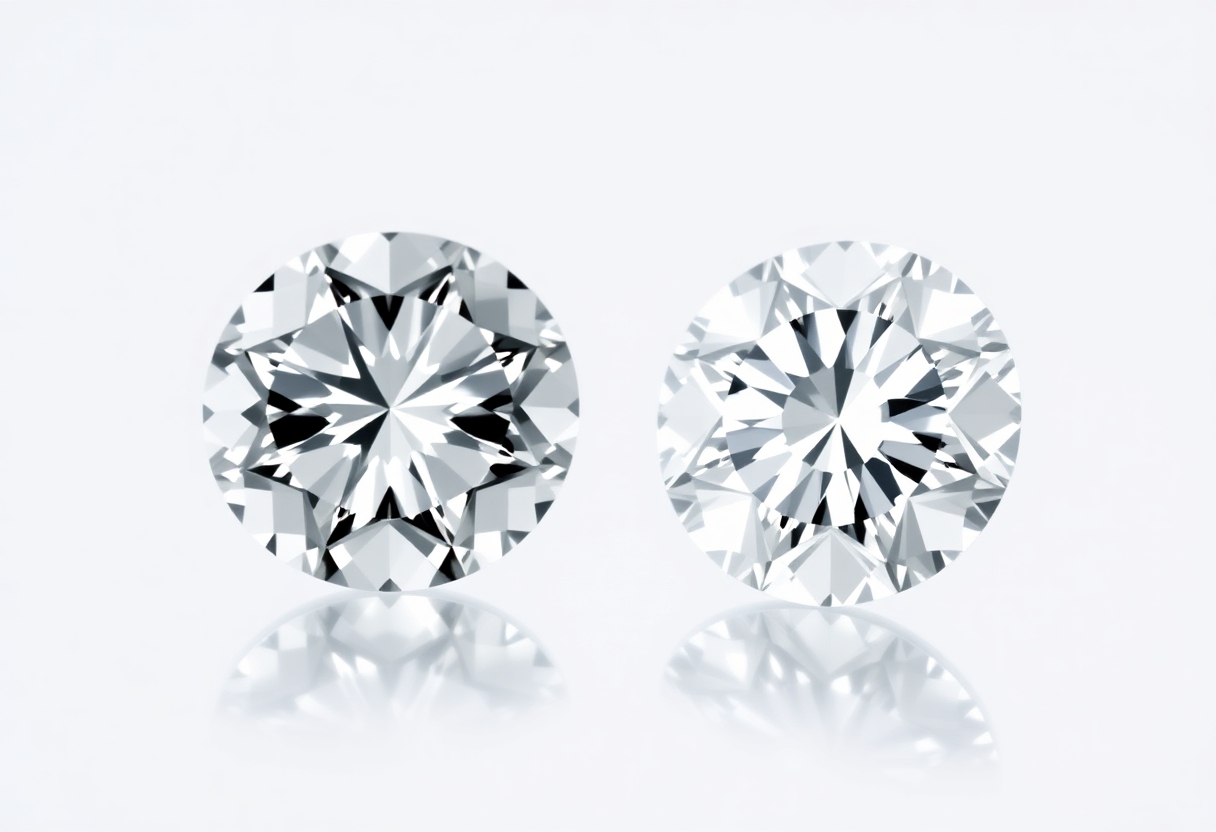If you’re on the search for the right classic diamond shape, you may have come across two stunning choices: the old European cut and the round brilliant diamond cut. Both of them have a round silhouette, though they offer different characteristics.
Both the European cut and round brilliant cut are great options for an engagement ring. The big difference lies in their facet pattern and sparkle factor.
We put together a guide on the biggest differences between the two diamond cuts. Read on to learn the pros and cons of each to determine which one is right for you or your loved one.
What Is a European Cut Diamond?
An old European cut diamond is a type of round diamond that was cut during the Art Deco period between 1890 and 1930. These were one of the predecessors to the most popular diamond shape which is the modern round brilliant cut diamond.
Old European cut diamonds are cut for carat weight rather than brilliance. They are slightly less sparkly than modern brilliant cut diamonds and feature 58 facets. Old European cuts allow more light to escape through the bottom, sometimes creating a dark circle at the center of the diamond.
But what makes European diamonds so special? Diamond cutters rely on their eyes rather than modern technology to hand-cut these antique stones, making each one completely unique.
What Is a Round Brilliant Cut Diamond?
The round brilliant cut is the most popular of all diamond shapes. It’s also the most brilliant as it’s “ideal cut.” This means it’s cut to the best possible proportions to achieve maximum brilliance.
A round brilliant cut diamond is so brilliant because it has the highest number of facets at 58. When the light enters a round cut diamond, it’s reflected through 58 facets before leaving the diamond. This results in maximum sparkle, making it the centerpiece of any wedding anniversary gift or everyday fine jewelry it’s set in.
No matter how fashion might change, you can rest assured that your round brilliant cut diamond will remain just as valuable as ever.
Differences Between European Cut vs. Round Brilliant
Although the two stone cuts both appear round, there are a lot of differences beneath the surface. If you’re deciding between the two shapes, it’s a good idea to understand the differences that make up each.
While the round brilliant is the most popular diamond cut, you may be surprised by some of the unique characteristics of an old European cut. From table to facets and brilliance, here are the main differences between a European cut vs. a round brilliant cut.
Brilliance
The most visible difference between an old European cut and the round brilliant is brilliance. The old European cut better showcases dispersion or “fire,” which results in multi-colored flashes of light. On the other hand, the round brilliant cut maximizes sparkle and brilliance which creates the classic black-and-white sparkle.
Both are brilliant in their own way. It’s up to you to decide which type of brilliance you prefer: more color or less.
Craftsmanship
One of the reasons old European cuts are still popular is because of their handcrafted details. When someone purchases a lab diamond engagement ring, the sentiment is of unique love between two people. This same premise is why many love the handcrafted details of the European cut.
The difference between the two is whether you prefer the unperfect craftsmanship of an old European cut, making it completely unique, or the precise craftsmanship of a round brilliant cut by machines.

Style
Though both the European cut and the round brilliant look similar in shape, they offer different styles. The round brilliant offers a classic, modern look when set in ethical engagement rings or fine jewelry. It pairs well with sleek ensembles and can be worn for just about any occasion. Along with its brilliance, this is why the round brilliant cut is such a popular diamond shape and cut.
On the other hand, the old European diamond cut takes on a more vintage appearance. This stems from its antique-looking facet pattern and slightly dimmed brilliance. It looks stunning when set in a vintage engagement ring, but offers a very different style than the modern round brilliant.
Details
Additional differences between the two stones stem from details like the table and culet size. Old European cut diamonds are famous for their small tables, which tend to be 53% of the diamond’s diameter or less. They also tend to have imperfect symmetry compared to circular brilliant cuts due to old-fashioned diamond cutting techniques. Round diamonds tend to have larger tables, with excellent or very good table sizes in the 52 to 60% range.
When it comes to the culet, old European cut diamonds tend to have a large culet that’s visible from the table of the diamond. On the other hand, a round brilliant cut diamond’s culet can vary in size.
Pros and Cons of the Old European Cut
So, what do all these differences mean and how do they affect the overall look and cost of a diamond? Let’s look at the pros and cons of each stone type to help you make the best decision for your next luxury jewelry purchase.
Pros of the old European cut:
- Of all the pros of the European cut, its one-of-a-kind craftsmanship is definitely top of the list.
- Another important pro to consider is its unique vintage appearance. With a European cut, you can be sure you’ll get the antique look you want from your sustainable jewelry.
- Although old European cut diamonds aren’t as brilliant as the modern diamond cut, they feature bright and dark, checkerboard-like flashes of light that can occur when an old European cut diamond is viewed from above.
- European cut diamonds also tend to be more cost-effective than round brilliant diamonds. This is because round brilliant diamonds are the most expensive, given their ideal brilliance and sparkle.
Cons of the old European cut:
- Because European cuts are rarer than round brilliant diamonds, the selection is limited, affecting your choice of cut, color, diamond clarity, and carat weight.
- Since most old European cut diamonds were cut by hand, they aren’t as precisely cut as a modern round brilliant.
- Since the cut quality of old European cut diamonds can vary so dramatically, the GIA doesn’t list a diamond cut grade of this type.
Is an Old European Cut Right For You?
Deciding whether an old European diamond cut is right for you can be a challenging task, especially when set in an engagement ring. After all, you want it to be the perfect representation of your love.
If you’re considering a European cut, it probably means you like your things to be unique and vintage looking. If that’s the case, an old European diamond will certainly fit the requirements. But also keep in mind the sparkle you expect from your diamond. With a modern brilliant cut, you can be sure you’re getting the maximum light return possible.
If you’re ready to say yes to the old European cut, consider these tips for buying the right diamond.
- Go vintage. The best settings for old European cut diamonds tend to be antique-looking engagement ring settings. You can even pair the vintage center stone with Art Deco-inspired accent stones to go all vintage.
- Consider a yellow or rose gold setting to enhance the vintage details. Many antique cut diamonds have fairly low color grades. Choosing a warm metal will actually hide hints of yellow.
Buy jewelry pieces from a jeweler you trust. When anything but custom just won’t do, buy a diamond engagement ring with round cut from a trusted jeweler like LuxyVerse. With our design team, we can turn your dream engagement ideas into a reality. Contact us to get started!






Leave a Comment